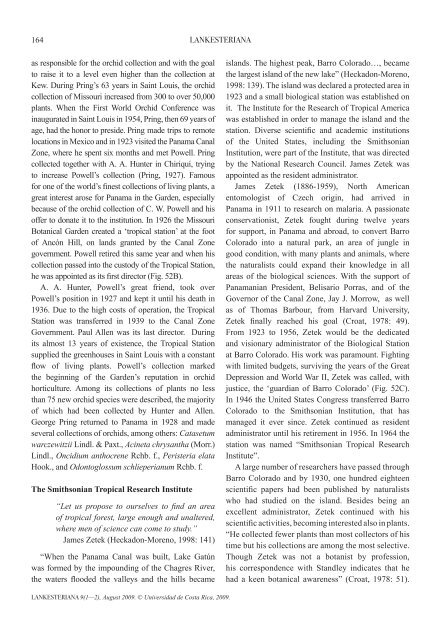orchids and orchidology in central america. 500 ... - lankesteriana.org
orchids and orchidology in central america. 500 ... - lankesteriana.org
orchids and orchidology in central america. 500 ... - lankesteriana.org
You also want an ePaper? Increase the reach of your titles
YUMPU automatically turns print PDFs into web optimized ePapers that Google loves.
164<br />
as responsible for the orchid collection <strong>and</strong> with the goal<br />
to raise it to a level even higher than the collection at<br />
Kew. Dur<strong>in</strong>g Pr<strong>in</strong>g’s 63 years <strong>in</strong> Sa<strong>in</strong>t Louis, the orchid<br />
collection of Missouri <strong>in</strong>creased from 300 to over 50,000<br />
plants. When the First World Orchid Conference was<br />
<strong>in</strong>augurated <strong>in</strong> Sa<strong>in</strong>t Louis <strong>in</strong> 1954, Pr<strong>in</strong>g, then 69 years of<br />
age, had the honor to preside. Pr<strong>in</strong>g made trips to remote<br />
locations <strong>in</strong> Mexico <strong>and</strong> <strong>in</strong> 1923 visited the Panama Canal<br />
Zone, where he spent six months <strong>and</strong> met Powell. Pr<strong>in</strong>g<br />
collected together with A. A. Hunter <strong>in</strong> Chiriquí, try<strong>in</strong>g<br />
to <strong>in</strong>crease Powell’s collection (Pr<strong>in</strong>g, 1927). Famous<br />
for one of the world’s f<strong>in</strong>est collections of liv<strong>in</strong>g plants, a<br />
great <strong>in</strong>terest arose for Panama <strong>in</strong> the Garden, especially<br />
because of the orchid collection of C. W. Powell <strong>and</strong> his<br />
offer to donate it to the <strong>in</strong>stitution. In 1926 the Missouri<br />
Botanical Garden created a ‘tropical station’ at the foot<br />
of Ancón Hill, on l<strong>and</strong>s granted by the Canal Zone<br />
government. Powell retired this same year <strong>and</strong> when his<br />
collection passed <strong>in</strong>to the custody of the Tropical Station,<br />
he was appo<strong>in</strong>ted as its first director (Fig. 52B).<br />
A. A. Hunter, Powell’s great friend, took over<br />
Powell’s position <strong>in</strong> 1927 <strong>and</strong> kept it until his death <strong>in</strong><br />
1936. Due to the high costs of operation, the Tropical<br />
Station was transferred <strong>in</strong> 1939 to the Canal Zone<br />
Government. Paul Allen was its last director. Dur<strong>in</strong>g<br />
its almost 13 years of existence, the Tropical Station<br />
supplied the greenhouses <strong>in</strong> Sa<strong>in</strong>t Louis with a constant<br />
flow of liv<strong>in</strong>g plants. Powell’s collection marked<br />
the beg<strong>in</strong>n<strong>in</strong>g of the Garden’s reputation <strong>in</strong> orchid<br />
horticulture. Among its collections of plants no less<br />
than 75 new orchid species were described, the majority<br />
of which had been collected by Hunter <strong>and</strong> Allen.<br />
Ge<strong>org</strong>e Pr<strong>in</strong>g returned to Panama <strong>in</strong> 1928 <strong>and</strong> made<br />
several collections of <strong>orchids</strong>, among others: Catasetum<br />
warczewitzii L<strong>in</strong>dl. & Paxt., Ac<strong>in</strong>eta chrysantha (Morr.)<br />
L<strong>in</strong>dl., Oncidium anthocrene Rchb. f., Peristeria elata<br />
Hook., <strong>and</strong> Odontoglossum schlieperianum Rchb. f.<br />
The Smithsonian Tropical Research Institute<br />
“Let us propose to ourselves to f<strong>in</strong>d an area<br />
of tropical forest, large enough <strong>and</strong> unaltered,<br />
where men of science can come to study.”<br />
James Zetek (Heckadon-Moreno, 1998: 141)<br />
“When the Panama Canal was built, Lake Gatún<br />
was formed by the impound<strong>in</strong>g of the Chagres River,<br />
the waters flooded the valleys <strong>and</strong> the hills became<br />
LANKESTERIANA<br />
LANKESTERIANA 9(1—2), August 2009. © Universidad de Costa Rica, 2009.<br />
isl<strong>and</strong>s. The highest peak, Barro Colorado…, became<br />
the largest isl<strong>and</strong> of the new lake” (Heckadon-Moreno,<br />
1998: 139). The isl<strong>and</strong> was declared a protected area <strong>in</strong><br />
1923 <strong>and</strong> a small biological station was established on<br />
it. The Institute for the Research of Tropical America<br />
was established <strong>in</strong> order to manage the isl<strong>and</strong> <strong>and</strong> the<br />
station. Diverse scientific <strong>and</strong> academic <strong>in</strong>stitutions<br />
of the United States, <strong>in</strong>clud<strong>in</strong>g the Smithsonian<br />
Institution, were part of the Institute, that was directed<br />
by the National Research Council. James Zetek was<br />
appo<strong>in</strong>ted as the resident adm<strong>in</strong>istrator.<br />
James Zetek (1886-1959), North American<br />
entomologist of Czech orig<strong>in</strong>, had arrived <strong>in</strong><br />
Panama <strong>in</strong> 1911 to research on malaria. A passionate<br />
conservationist, Zetek fought dur<strong>in</strong>g twelve years<br />
for support, <strong>in</strong> Panama <strong>and</strong> abroad, to convert Barro<br />
Colorado <strong>in</strong>to a natural park, an area of jungle <strong>in</strong><br />
good condition, with many plants <strong>and</strong> animals, where<br />
the naturalists could exp<strong>and</strong> their knowledge <strong>in</strong> all<br />
areas of the biological sciences. With the support of<br />
Panamanian President, Belisario Porras, <strong>and</strong> of the<br />
Governor of the Canal Zone, Jay J. Morrow, as well<br />
as of Thomas Barbour, from Harvard University,<br />
Zetek f<strong>in</strong>ally reached his goal (Croat, 1978: 49).<br />
From 1923 to 1956, Zetek would be the dedicated<br />
<strong>and</strong> visionary adm<strong>in</strong>istrator of the Biological Station<br />
at Barro Colorado. His work was paramount. Fight<strong>in</strong>g<br />
with limited budgets, surviv<strong>in</strong>g the years of the Great<br />
Depression <strong>and</strong> World War II, Zetek was called, with<br />
justice, the ‘guardian of Barro Colorado’ (Fig. 52C).<br />
In 1946 the United States Congress transferred Barro<br />
Colorado to the Smithsonian Institution, that has<br />
managed it ever s<strong>in</strong>ce. Zetek cont<strong>in</strong>ued as resident<br />
adm<strong>in</strong>istrator until his retirement <strong>in</strong> 1956. In 1964 the<br />
station was named “Smithsonian Tropical Research<br />
Institute”.<br />
A large number of researchers have passed through<br />
Barro Colorado <strong>and</strong> by 1930, one hundred eighteen<br />
scientific papers had been published by naturalists<br />
who had studied on the isl<strong>and</strong>. Besides be<strong>in</strong>g an<br />
excellent adm<strong>in</strong>istrator, Zetek cont<strong>in</strong>ued with his<br />
scientific activities, becom<strong>in</strong>g <strong>in</strong>terested also <strong>in</strong> plants.<br />
“He collected fewer plants than most collectors of his<br />
time but his collections are among the most selective.<br />
Though Zetek was not a botanist by profession,<br />
his correspondence with St<strong>and</strong>ley <strong>in</strong>dicates that he<br />
had a keen botanical awareness” (Croat, 1978: 51).
















